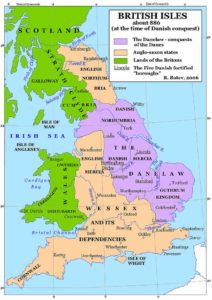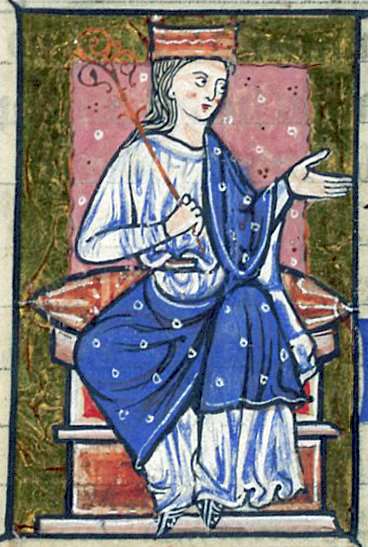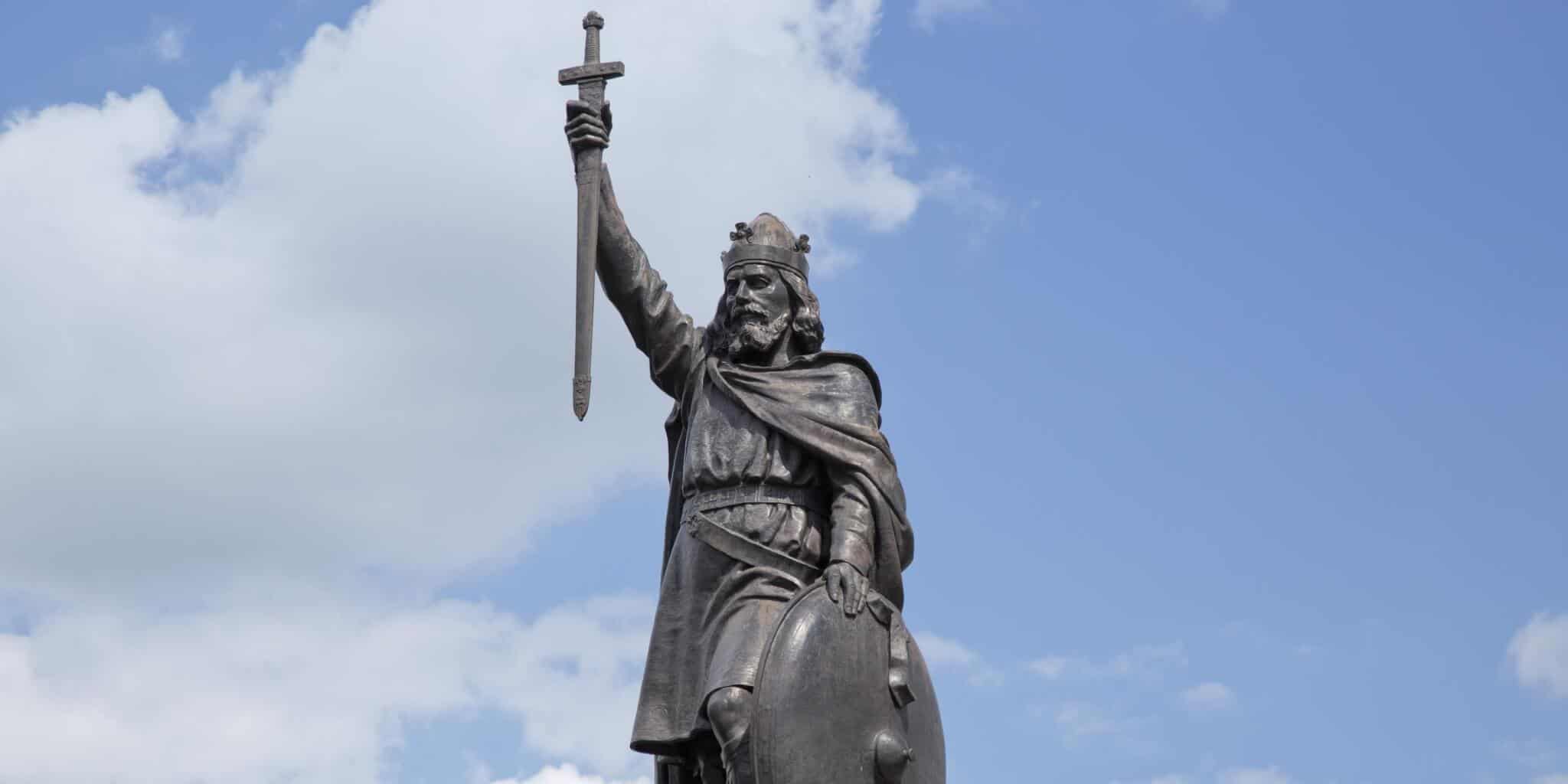The five boroughs of Danelaw were the five most important towns existing under Danish law and customs, located in the territory of Danish Mercia. These five crucial locations included Leicester, Nottingham, Derby, Stamford and Lincoln, which by the ninth century were under the sway and control of the Vikings.
The reference to Danelaw is found in one of the most important sources for this period, the Anglo-Saxon Chronicle. The term essentially refers to the areas under Danish laws and customs, later expanding in understanding to mean the geographical boundaries designated by the agreement. The Danelaw was at its pinnacle an all-encompassing territory which spread from London to East Anglia, through the Midlands and up to the north of England.

The late eighth century and early ninth century was a time of action, land-grabs, conquest and raiding parties. In Northern Europe, the Vikings had set their sights on the British Isles, keen to embark on successful naval expeditions in search of territory, wealth and prestige.
The Vikings had become a dominating military and naval force and in 793 a group of Norwegian Vikings attacked the famous abbey at Lindisfarne. This was to be the first of many raids which were launched against Britain in the following centuries, with Norse raiding parties attacking areas in Scotland, the Shetlands, Orkneys, Hebrides, Isle of Man and Ireland. The Danes focused their attention on Mercia as well as the kingdom of Wessex, thus necessitating a plan of action from Alfred the Great.

In 865 the Viking raids took on a new dimension, with the armies combining and landing in East Anglia with the ambition of conquering the Anglo-Saxon kingdoms. The two formidable brothers Halfdan and Ivar the Boneless as well as Viking warlord Guthrum, headed the coalition of forces known as the Great Heathen Army.
The Vikings proved successful in their mission, the Great Heathen Army managing to drive out the Mercian king Burgred, forcing him to flee and appointing the Mercian Ceolwulf II as king instead. In doing so, they demanded oaths of loyalty to the Vikings.
In the meantime, Halfdan took his men north to Northumbria, whilst Ceolwulf was installed to preside over the western kingdom. Guthrum however had his sights set on the territory belonging to Alfred the Great, focusing his attention on acquiring Wessex.
In order to enact his plan, he initiated an expedition, sailing around Poole Harbour and then combining his forces to invade the area. Whilst Alfred attempted to broker peace, Guthrum remained undeterred and launched a surprise attack on Alfred and his Anglo-Saxon kingdom on 6th January 878 whilst they celebrated Epiphany. The invasion forced Alfred to flee, taking shelter on the Somerset Levels whilst at the same time gathering together forces in order to wage war with Guthrum once more, culminating in the Battle of Edington.

In 878, Alfred and Guthrum’s battle for territory came to a head. The Battle of Edington concluded with a victory for Alfred’s forces who had besieged Guthrum’s army, forcing an important peace treaty known as the Treaty of Wedmore.
Under these new conditions, boundaries were clearly defined and Guthrum was forced to convert to Christianity, taking the name Aethelstan and Alfred serving as his godfather. As part of the peace that was brokered emerged the foundation of the Danelaw.
Guthrum no longer sought to break the conditions, leaving the boundaries uncontested and turning his attention to East Anglia, where he settled and created the Kingdom of Guthrum, where he settled until his death.
In the east, the area of Danish Mercia was ruled by five Danish armies who settled in the area, introducing their native law and customs and holding on to the five boroughs which served as important territory and bases for political power. As part of the Danelaw, five main towns were established: Derby, Leicester, Lincoln, Nottingham and Stamford.
The Five Boroughs were referred to as such because of their fortifications, as ‘borough’ derives from the Old English world ‘burh’ (or ‘burg’), roughly translating from the German “burg” meaning castle. Therefore as part of the town’s structure, fortifications and surrounding walls enclosed the residents, protecting them from attacks.
In total, the Danelaw would amount to around fifteen shires which included: Leicester, Nottingham, Derby, Lincoln, York, Essex, Cambridge, Suffolk, Northampton, Norfolk, Huntingdon, Bedford, Middlesex, Hertford and Buckinghamshire.
In the following years, these areas would become a distinguished part of the country where its leaders held great sway. Each borough was ruled as a Danish Jarldom, with power to control the lands of the fortified towns whilst answering to overlords in the Viking Kingdom of York also known as Jorvik.
One important borough was Nottingham, which was occupied by the Vikings in 868 under the leadership of Ivar the Boneless and Halfdan Ragnarsson who had set up winter quarters there. Danish settlement officially began around 877 and lasted until 918 when Edward of Wessex assaulted the fortified town in the summer. In response, Edward set up another burh two years later as a buffer area in which to fortify the settlement from further Danish incursions, amounting to around 39 acres of land comprising Saxon Nottingham.

The second borough included Derby, an area settled by the Danes in 877 and ruled under Danelaw until 913 when Lady Aethelflaed of Mercia established a burh nearby and launched a campaign against the Danish. Sensing her time to act was now, since the local ruler was allied with armies in Northampton and Leicester, she successfully assaulted Derby in July 917, bringing the area into the control of English Mercia.
Meanwhile, the borough at Lincoln was in an important strategic area on the route between Wessex and York. In this location however it was protected from the majority of the fighting between Anglo-Saxons and Danish Vikings because it was incredibly isolated. The Danes maintained their control in the area until 918 when the Danes began to cede control of territories on the border of Mercia and Wessex.
Danish rule survived in the area of Stamford and remained unaffected by attempts of the West Saxon Ealdorman Aethelnoth. Eventually however, King Edward launched a successful assault in May 918, forcing the Danes to concede defeat, failing to overpower the army of Wessex.
One of the most significant of the five boroughs was Leicester which faced off the threats from King Edward the Elder and Athelflaed who had set up a borough at Warwick. By 917 the forces were overwhelming, with a major assault being launched in three stages until eventually in 918, under attack and with the local countryside ravaged by a Mercian army, the fortress town surrendered to Aethelfaed’s troops.
Despite attempts to restore Danish control, by 942 King Edmund had recovered the five boroughs, a significant event which was commemorated in a poem entitled “Capture of the Five Boroughs”.
The impact of Danelaw and its implementation however cannot be underestimated. It marked a concerted effort by individuals on both sides to establish peaceful conditions for civilians to co-exist, with neighbouring Anglo-Saxon and Viking communities living under their respective laws and customs.
Jessica Brain is a freelance writer specialising in history. Based in Kent and a lover of all things historical.







